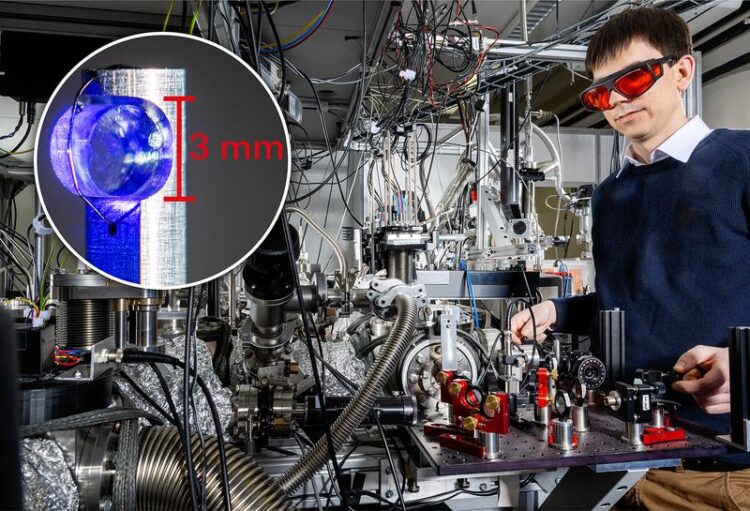Laser excitation of a nucleus

PTB scientist Johannes Tiedau with the laser setup and vacuum system for the investigation of the thorium-229 nucleus. Inset top left: Thorium-doped calcium fluoride crystal from TU Wien.
(c) PTB
A long-awaited breakthrough opens the door to a new type of atomic clock and the investigation of fundamental questions in physics.
After decades of investigation, researchers made an extraordinary quantum leap – both figuratively and literally: They have identified the exact laser frequency that excites the atomic nucleus of the element thorium-229 to make a quantum leap from one energy level to a closely adjacent one. This kind of laser nuclear excitations opens the door to new types of atomic clocks that could be more accurate than the atomic clocks we have today. They would enable measurements of unprecedented precision – for deep insights into the quantum world, new knowledge about the origin of the universe, and the properties of dark matter. A collaboration between the Physikalisch-Technische Bundesanstalt in Germany and TU Wien has made this possible. The scientific paper has now been published in the journal Physical Review Letters.
In contrast to atomic nuclei, the excitation of electrons in the atomic shell has long been a widely used method: When the wavelength of a laser is precisely tuned, an electron changes from one state to another. In this way, the energy characteristic exists in an atom or molecule can be measured very precisely. Many precision metrological techniques, such as today’s atomic clocks and chemical analysis methods, are based on this principle. To store information in atoms or molecules, lasers are also used in quantum computers.
For a long time, it seemed impossible to apply these techniques to atomic nuclei, which can also exist in different quantum states. However, this would require at least higher energy by a factor of thousands than the energy needed to excite electrons. Atomic nuclei would be the perfect quantum objects for precision measurements: Surrounded by the electron shell, they are protected and thus much less susceptible to external perturbations. In principle, they would allow measurements of unprecedented accuracy.
Since the 1970s, it has been speculated that the atomic nucleus of the isotope thorium-229 could be specifically excited by a laser. It has two very closely adjacent states of energy, so a laser should be sufficient to change the state of the nucleus. But for a long time, there was only indirect evidence that this transition existed. This is because the only vaguely known energy of the transition must be hit with a laser that is tuned to an accuracy of one millionth of an electronvolt in order to excite it in a targeted manner.
To solve this problem, PTB and TU Wien launched a cooperation project in 2020, funded by the European Research Council. At PTB, a laser system with the required ultraviolet wavelength of about 148 nm was developed, while TU Wien produced crystals into which the thorium nuclei were specifically incorporated in large numbers. Both tasks were not only groundbreaking but also technically very complex. In the end, however, they made it possible to hit about ten quadrillion (1016) thorium nuclei simultaneously with the laser, i. e., the nuclear response to laser excitation can be amplified, the necessary measuring time can be reduced, and the probability of finding the desired energy transition can be increased.
The researchers thus succeeded in precisely hitting the energy of the targeted thorium transition and for the first time the thorium nuclei delivered a clear signal: The laser beam had specifically switched their state.
The successful laser nuclear excitation is now paving the way to a nuclear clock that could be significantly more accurate than the atomic clocks of today. It could help to answer some fundamental questions of quantum research about the origin of our world – e.g. whether the constants of nature have remained constant since the Big Bang. And if the thorium-doped crystals that have now been realized are further developed, thorium nuclei could be specifically incorporated into crystals or molecules as probes and make new information about microscopic material properties accessible there.
Wissenschaftliche Ansprechpartner:
Dr. Ekkehard Peik, Department 4.4 “Time and Frequency”, phone: +49 531 592-4400, email: ekkehard.peik@ptb.de
Originalpublikation:
J. Tiedau et al.: Laser excitation of the Th-229 nucleus. Phys. Rev. Lett.
https://journals.aps.org/prl/accepted/2c07aYbeC981d47c171619f5604116053962ac79a
https://www.ptb.de/cms/en/presseaktuelles/journalisten/news-press-releases/press-release.html?…
Media Contact
All latest news from the category: Physics and Astronomy
This area deals with the fundamental laws and building blocks of nature and how they interact, the properties and the behavior of matter, and research into space and time and their structures.
innovations-report provides in-depth reports and articles on subjects such as astrophysics, laser technologies, nuclear, quantum, particle and solid-state physics, nanotechnologies, planetary research and findings (Mars, Venus) and developments related to the Hubble Telescope.
Newest articles

New theory reveals the shape of a single photon
A new theory, that explains how light and matter interact at the quantum level has enabled researchers to define for the first time the precise shape of a single photon….

Perovskite research boosts solar cell efficiency and product life
An international team led by the University of Surrey with Imperial College London have identified a strategy to improve both the performance and stability for solar cells made out of…

Neuroscientists discover how the brain slows anxious breathing
Salk scientists identify brain circuit used to consciously slow breathing and confirm this reduces anxiety and negative emotions. Deep breath in, slow breath out… Isn’t it odd that we can…



